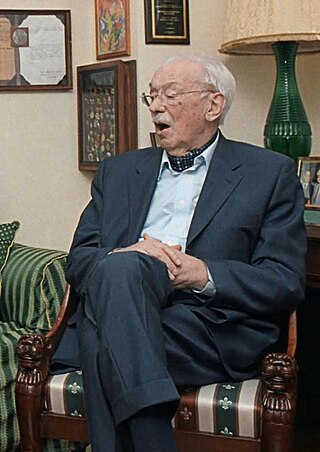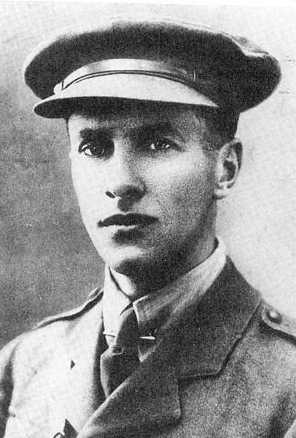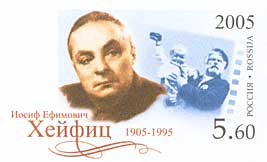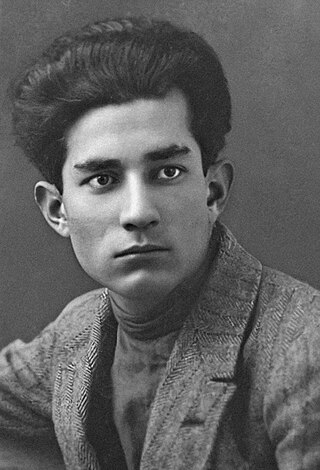
The Republics of the Union of Soviet Socialist Republics or the Union Republics were national-based administrative units of the Union of Soviet Socialist Republics (USSR). The Soviet Union was formed in 1922 by a treaty between the Soviet republics of Byelorussia, Russian SFSR (RSFSR), Transcaucasian Federation, and Ukraine, by which they became its constituent republics of the Union of Soviet Socialist Republics.

Sergey Vladimirovich Mikhalkov was a Soviet and Russian author of children's books and satirical fables. He wrote the lyrics for the Soviet and Russian national anthems.

The Order of the Red Banner was the first Soviet military decoration. The Order was established on 16 September 1918, during the Russian Civil War by decree of the All-Russian Central Executive Committee. It was the highest award of Soviet Russia, subsequently the Soviet Union, until the Order of Lenin was established in 1930. Recipients were recognised for extraordinary heroism, dedication, and courage demonstrated on the battlefield. The Order was awarded to individuals as well as to military units, cities, ships, political and social organizations, and state enterprises. In later years, it was also awarded on the twentieth and again on the thirtieth anniversary of military, police, or state security service without requiring participation in combat.

Walter Duranty was an Anglo-American journalist who served as Moscow bureau chief of The New York Times for fourteen years (1922–1936) following the Bolshevik victory in the Russian Civil War (1918–1921).

The International Lenin Peace Prize was a Soviet Union award named in honor of Vladimir Lenin. It was awarded by a panel appointed by the Soviet government, to notable individuals whom the panel indicated had "strengthened peace among comrades". It was founded as the International Stalin Prize for Strengthening Peace Among Peoples, but was renamed the International Lenin Prize for Strengthening Peace Among Peoples as a result of de-Stalinization. Unlike the Nobel Prize, the Lenin Peace Prize was usually awarded to several people a year rather than to just one individual. The prize was mainly awarded to prominent Communists and supporters of the Soviet Union who were not Soviet citizens. Notable recipients include W. E. B. Du Bois, Fidel Castro, Lázaro Cárdenas, Salvador Allende, Mikis Theodorakis, Seán MacBride, Angela Davis, Pablo Picasso, Oscar Niemeyer, Faiz Ahmad Faiz, Abdul Sattar Edhi, Funmilayo Ransome-Kuti, CV Raman and Nelson Mandela.

The Lenin Prize was one of the most prestigious awards of the Soviet Union for accomplishments relating to science, literature, arts, architecture, and technology. It was originally created on June 23, 1925, and awarded until 1934. During the period from 1935 to 1956, the Lenin Prize was not awarded, being replaced largely by the Stalin Prize. On August 15, 1956, it was reestablished, and continued to be awarded on every even-numbered year until 1990. The award ceremony was April 22, Vladimir Lenin's birthday.

Science and technology in the Soviet Union served as an important part of national politics, practices, and identity. From the time of Lenin until the dissolution of the USSR in the early 1990s, both science and technology were intimately linked to the ideology and practical functioning of the Soviet state and were pursued along paths both similar and distinct from models in other countries. Many great scientists who worked in Imperial Russia, such as Konstantin Tsiolkovsky, continued work in the USSR and gave birth to Soviet science.

The Order of Victory was the highest military decoration awarded for World War II service in the Soviet Union, and one of the rarest orders in the world. The order was awarded only to Generals and Marshals for successfully conducting combat operations involving one or more army groups and resulting in a "successful operation within the framework of one or several fronts resulting in a radical change of the situation in favor of the Red Army." The Order of Victory is a standalone decoration awarded specially for service in World War II; unlike other awards such as the Hero of the Soviet Union, it does not belong to any order of ranking. In the history of the Soviet Union, the award had been awarded twenty times to twelve Soviet leaders and five foreign leaders, with one revocation. The last living recipient was King Michael I of Romania, who died on 5 December 2017.
The title of Hero is presented by various governments in recognition of acts of self-sacrifice to the state, and great achievements in combat or labor. It is originally a Soviet-type honor, and is continued by several nations including Belarus, Russia, and Ukraine. It was also awarded to cities and fortresses for collective efforts in heroic feats. Each hero receives a medal for public display, special privileges and rights for life, and the admiration and respect of the nation. Some countries without Soviet connections also award Hero honours.
Velimuhammet Muhadov or Welimuhammet Muhadow, also known as Veli Muhadov or Weli Muhadow, was a Turkmen composer.

The Medal "For the Victory over Japan" was a campaign medal of the Soviet Union established on September 30, 1945 by decree of the Presidium of the Supreme Soviet of the Soviet Union to commemorate the Soviet victory over the Empire of Japan in the Soviet–Japanese War at the end of World War II. The medal's statute was later amended on July 18, 1980 by decree of the Presidium of the Supreme Soviet of the USSR № 2523-X.

Samad Vurgun was an Azerbaijani and Soviet poet, dramatist, public figure, first People's Artist of the Azerbaijan SSR (1943), academician of Azerbaijan National Academy of Sciences (1945), laureate of two Stalin Prizes of second degree, and member of the Communist Party of the Soviet Union from 1940.

Yuli Yakovlevich Raizman was a Soviet and Russian film director, screenwriter and pedagogue. People's Artist of the USSR (1964) and Hero of Socialist Labour (1973).

Iosif Yefimovich Kheifits was a Soviet film director, winner of two Stalin Prizes, People's Artist of USSR (1964), Hero of Socialist Labor (1975). Member of the Communist Party of Soviet Union since 1945.

The Medal "For Valiant Labour in the Great Patriotic War 1941–1945" was a World War II civilian labour award of the Soviet Union established on June 6, 1945 by decree of the Presidium of the Supreme Soviet of the USSR to recognise the valiant and selfless labour of Soviet citizens in the Soviet Union's victory over Nazi Germany in the Great Patriotic War. Its statute was later amended by decree of the Presidium of the Supreme Soviet of the USSR on July 18, 1980.

Mikayil Alasger oghlu Huseynov was a Soviet Azerbaijani architect and historian of architecture. He was People's Architect of the USSR (1970), Professor (1939); Academician of the Academy of Sciences of the USSR (1945), full member of the Academy of Architecture of the USSR (1985), Hero of Socialist Labour (1985), laureate of the Second Class State Stalin Prize (1941), member of England's and Ireland's Royal Society of Asians.
The year 1952 was marked by many events that left an imprint on the history of Soviet and Russian Fine Arts.

Mehdi Ali oglu Huseynov – famed under the pseudonym Mehdi Huseyn was an Azerbaijani and Soviet writer and critic, laureate of the State Stalin Prize of the third degree (1950) and member of the All-Union Communist Party since 1941.
Oleg Konstantinovich Komov was a prominent Soviet-Russian sculptor and graphics artist.















